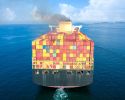Social sustainability at sea must be measurable

Social Sustainability Needs to Improve at Sea – But How? A new pre-study, initiated by Lighthouse and funded by the Swedish Seamen’s Foundation, highlights five key themes that characterize social sustainability at sea—one of which is the lack of clear and uniform criteria for measuring it.
Within the maritime sector, much attention is given to environmental and economic sustainability, but social sustainability is rarely discussed. This may not be surprising, yet this third pillar also needs to be strengthened if the industry is to be considered sustainable in the future. However, this is no easy task.
"Social sustainability and working conditions on board vary significantly depending on the flag state and national regulations. That makes it very difficult to address these issues at a single level. In Sweden, we have strong occupational health and safety legislation and focus on improving the psychosocial work environment. In many other countries, discussions about mental well-being have barely begun—the focus is still on physical working conditions," says Johanna Larsson, research assistant at VTI and one of the authors of the report Waves of Well-being – Measuring Social Sustainability in the Maritime Sector.
The purpose of the report is to develop measurable and action-oriented criteria to strengthen social sustainability at sea. The idea is to integrate these criteria into the international Clean Shipping Index, which compares ships and shipping companies and helps cargo owners, ports, and other stakeholders choose more sustainable maritime transport. The index already includes a structured set of sustainability indicators, but so far, the focus has been on ships’ environmental performance.
"We want to broaden the perspective and include social sustainability as well. It is important to establish measurable criteria that can be regularly monitored. Regulations that are subject to inspection and enforcement are followed—they are seen as important. Other issues risk being considered voluntary," Larsson explains.
The report is based on literature studies, a workshop, and interviews with 11 stakeholders from various organizations, including research institutes, authorities, industry organizations, and trade unions.
"We have also spoken with people who inspect ships and have seen the full spectrum of vessels calling at Swedish ports," Larsson adds.
The report identifies five key themes relevant to social sustainability efforts. The first theme highlights the need for greater attention and more resources for social sustainability. What does social sustainability even mean? Definitions varied among study participants—some referred to the UN Sustainable Development Goals (SDGs), while others had more subjective interpretations.
The second theme addresses the deeply ingrained maritime culture. It is described as hierarchical and rigid, with little inclination for change, which complicates efforts to improve social sustainability. The captain plays a key role in shaping the onboard environment, but the structure can discourage crew members from raising concerns about safety and well-being. However, Larsson points out that significant improvements have been made since the Maritime Labour Convention (MLC)—which guarantees seafarers’ rights to decent working and living conditions—came into force in 2013.
"Of course, some countries do not comply with the convention, but it has nevertheless raised industry standards overall. The #MeToo movement has also led to improvements in combating sexual harassment, with the establishment of reporting systems that bypass traditional hierarchies," she says.
The third theme, Regulations and Support Mechanisms, focuses on the fact that laws and conventions, such as the MLC, are not always enforced, leading to significant disparities in working conditions between different flag states.
"Food is also important. Every single person we interviewed mentioned it. There should be a proper chef on board, serving good and nutritious meals."
This brings us to the fourth theme, Living Onboard. Seafarers spend months at a time on their workplace, which can lead to social isolation and mental health challenges. Access to the internet, a good living environment, and opportunities for social interaction are crucial for improving life at sea.
The fifth and final theme concerns the need to develop indicators to measure social sustainability. These indicators can be divided into two categories: fundamental aspects (such as fair wages and working conditions) and organizational aspects (such as leadership support and crew cohesion). According to the report, these indicators must be both qualitative and quantitative to fully capture the scope of social sustainability issues.
"The criteria are presented in an appendix to the report. More work is needed to refine them—for example, they need clearer measurement values. This is part of IVL's ongoing efforts to integrate them into the Clean Shipping Index," Larsson explains.
The report Waves of Well-being – Measuring Social Sustainability in the Maritime Sector was authored by Johanna Larsson (VTI), Elin Malmgren (IVL Swedish Environmental Research Institute), Joakim Dahlman (VTI), and Erik Fridell (IVL Swedish Environmental Research Institute).
-
 Ny studie: Eldrivna pendelbåtar kan effektivisera Stockholms kollektivtrafik
Ny studie: Eldrivna pendelbåtar kan effektivisera Stockholms kollektivtrafik -
 Sjöfartens utsläpp ökar
Sjöfartens utsläpp ökar -
 Sociala relationer påverkar val av bränsle
Sociala relationer påverkar val av bränsle -
 Sjöfartens omställning kräver ”mjukare” påtryckningar
Sjöfartens omställning kräver ”mjukare” påtryckningar -
 Hon hade avtalad tid med Kapten ynkrygg
Hon hade avtalad tid med Kapten ynkrygg -
 Lighthouse omvärldsanalys 2025 – osäkerhet och tullar präglar sjöfarten
Lighthouse omvärldsanalys 2025 – osäkerhet och tullar präglar sjöfarten -
 Se seminariet Shipping in the Marine Environment
Se seminariet Shipping in the Marine Environment -
 Vad betyder egentligen de 90 procenten?
Vad betyder egentligen de 90 procenten? -
 Hålla där...
Hålla där... -
 Ny rapport: Klimatförändringarna ett hot mot de flesta större hamnar i världen
Ny rapport: Klimatförändringarna ett hot mot de flesta större hamnar i världen

